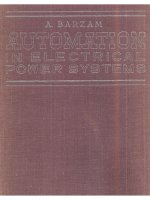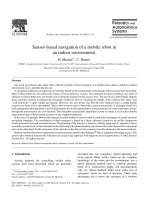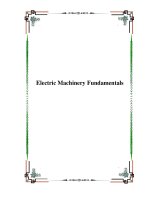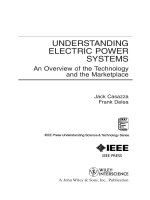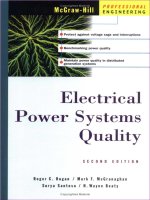Electric Power Systems docx
Bạn đang xem bản rút gọn của tài liệu. Xem và tải ngay bản đầy đủ của tài liệu tại đây (4.02 MB, 514 trang )
Electric Power
Systems
Electric Power
Systems
B.M. Weedy | B.J. Cory
N. Je
NkiNs | J.B. ekaNay
ake
| G. strBaC
FIFTH EDITION
FI
FTH EDITION
Red box rules are for proof stage only. Delete before final printing.
Electric Power Systems
FIFTH
EDITION
WEEDY
CORY
JENKINS
EKANAYAKE
STRBAC
Electric power systems are going through a period of dramatic change with the need
to
reduce environmental impact, provide a secure supply of power to an increasing
world population while aging infrastructure and equipment in many established systems
needs replacing.
Today’s student has to understand both the large amount of plant and
equipment that is in use as well as the possibilities offered by new technologies.
Now comprehensively updated and revised, the fifth edition of this classic textbook
provides a modern foundation in power systems engineering.
The emphasis on practical
analysis, modelling and fundamental principles, so successful in previous editions, is
retained together with broad coverage of the subject while avoiding complex mathematics.
Throughout, the worked examples and computer simulations used to explain concepts
and calculation techniques have been modernised, as have all figures.
Features of the fifth edition:
www.wiley.com/go/weedy_electric
fundamental principles
source converters
For instructors and teachers, solutions to the problems set out in the book can be found
on the companion website.
Offering enhanced, clear and concise explanations of practical applications, this updated
edition will ensure that Electric Power Systems
continues to be an invaluable resource
for senior undergraduates in electrical engineering.
Electric Power
Systems
FIFTH EDITION
B.M. WEEDY, University of Southampton, UK
B.J. CORY,
Imperial College London, UK
N. JENKINS, Cardiff University
, UK
J.
B. EKANAY
AK
E, Cardiff University
, UK
, Imperial College London, UK
Electric Power Systems
Electric Power Systems
Fifth Edition
B.M. Weedy, University of Southampton, UK
B.J. Cory, Imperial College Londo n, UK
N. Jenkins, Cardiff University, UK
J.B. Ekanayake, Cardiff University, UK
G. Strbac, Imperial College London, UK
This edition first published 2012
#
2012, John Wiley & Sons Ltd
Registered office
John Wiley & Sons Ltd, The Atrium, Southern Gate, Chichester, West Sussex, PO19 8SQ, United Kingdom
For details of our global editorial offices, for customer services and for information about how to apply for
permission to reuse the copyright material in this book please see our website at www.wiley.com.
The right of the author to be identified as the author of this work has been asserted in accordance with the
Copyright, Designs and Patents Act 1988.
All rights reserved. No part of this publication may be reproduced, stored in a retrieval system, or trans-
mitted, in any form or by any means, electronic, mechanical, photocopying, recording or otherwise,
except as permitted by the UK Copyright, Designs and Patents Act 1988, without the prior permission of
the publisher.
Wiley also publishes its books in a variety of electronic formats. Some content that appears in print may
not be available in electronic books.
Designations used by companies to distinguish their products are often claimed as trademarks. All brand
names and product names used in this book are trade names, service marks, trademarks or registered
trademarks of their respective owners. The publisher is not associated with any product or vendor men-
tioned in this book. This publication is designed to provide accurate and authoritative information in
regard to the subject matter covered. It is sold on the understanding that the publisher is not engaged in
rendering professional services. If professional advice or other expert assistance is required, the services
of a competent professional should be sought.
Library of Congress Cataloging-in-Publication Data
Electric power systems / Brian M. Weedy [ et al.]. – 5th ed.
p. cm.
Includes bibliographical references and index.
ISBN 978-0-470-68268-5 (cloth)
1. Electric power systems–Textbooks. 2. Electric power
transmission–Textbooks. I. Weedy, Brian M.
TK1001.E4235 2012
621.319’1–dc23
2012010322
A catalogue record for this book is available from the British Library.
Print ISBN: 9780470682685
Set in 10/12.5pt, Palatino-Roman by Thomson Digital, Noida, India
Contents
Preface to First Edition ix
Preface to Fourth Edition xi
Preface to Fifth Edition xiii
Symbols xv
1 Introduction 1
1.1 History 1
1.2 Characteristics Influencing Generation and Transmission 2
1.3 Operation of Generators 4
1.4 Energy Conversion 5
1.5 Renewable Energy Sources 12
1.6 Energy Storage 17
1.7 Environmental Aspects of Electrical Energy 23
1.8 Transmission and Distribution Systems 27
1.9 Utilization 40
Problems 43
2 Basic Concepts 45
2.1 Three-Phase Systems 45
2.2 Three-Phase Transformers 55
2.3 Active and Reactive Power 57
2.4 The Per-Unit System 61
2.5 Power Transfer and Reactive Power 68
2.6 Harmonics in Three-Phase Systems 74
2.7 Useful Network Theory 75
Problems 78
3 Components of a Power System 83
3.1 Introduction 83
3.2 Synchronous Machines 83
3.3 Equivalent Circuit Under Balanced Short-Circuit Conditions 90
3.4 Synchronous Generators in Parallel 94
3.5 The Operation of a Generator on an Infinite Busbar 95
3.6 Automatic Voltage Regulators (AVRs) 100
3.7 Lines, Cables and Transformers 103
3.8 Transformers 124
3.9 Voltage Characteristics of Loads 131
Problems 134
4 Control of Power and Frequency 139
4.1 Introduction 139
4.2 The Turbine Governor 142
4.3 Control Loops 146
4.4 Division of Load between Generators 147
4.5 The Power-Frequency Characteristic of an Interconnected System 151
4.6 System Connected by Lines of Relatively Small Capacity 152
Problems 159
5 Control of Voltage and Reactive Power 161
5.1 Introduction 161
5.2 The Generation and Absorption of Reactive Power 163
5.3 Relation between Voltage, Power, and Reactive Power at a Node 165
5.4 Methods of Voltage Control: (a) Injection of Reactive Power 170
5.5 Methods of Voltage Control: (b) Tap-Changing Transformers 176
5.6 Combined Use of Tap-Changing Transformers and Reactive -Power
Injection 183
5.7 Phase-Shift Transformer 188
5.8 Voltage Collapse 191
5.9 Voltage Control in Distribution Networks 195
5.10 Long Lines 197
5.11 General System Considerations 198
Problems 200
6 Load Flows 205
6.1 Introduction 205
6.2 Circuit Analysis Versus Load Flow Analysis 206
6.3 Gauss-Seidel Method 212
6.4 Load Flows in Radial and Simple Loop Networks 216
6.5 Load Flows in Large Systems 219
6.6 Computer Simulations 231
Problems 234
vi Contents
7 Fault Analysis 239
7.1 Introduction 239
7.2 Calculation of Three-Phase Balanced Fault Currents 241
7.3 Method of Symmetrical Components 247
7.4 Representation of Plant in the Phase-Sequence Networks 251
7.5 Types of Fault 252
7.6 Fault Levels in a Typical System 259
7.7 Power in Symmetrical Components 265
7.8 Systematic Methods for Fault Analysis in Large Networks 265
7.9 Neutral Grounding 270
7.10 Interference with Communication Circuits–Electromagnetic
Compatibility (EMC) 274
Problems 275
8 System Stability 281
8.1 Introduction 281
8.2 Equation of Motion of a Rotating Machine 283
8.3 Steady-State Stability 284
8.4 Transient Stability 287
8.5 Transient Stability–Consideration of Time 293
8.6 Transient Stability Calculations by Computer 298
8.7 Dynamic or Small-Signal Stability 301
8.8 Stability of Loads Leading to Voltage Collapse 305
8.9 Further Aspects 309
8.10 Multi-Machine Systems 311
8.11 Transient Energy Functions (TEF) 312
8.12 Improvement of System Stability 314
Problems 315
9 Direct-Current Transmission 319
9.1 Introduction 319
9.2 Current Source and Voltage Source Converters 320
9.3 Semiconductor Valves for High-Voltage Direct-Current
Converters 322
9.4 Current Source Converter h.v.d.c. 325
9.5 Voltage Source Converter h.v.d.c. 346
Problems 352
10 Overvoltages and Insulation Requirements 355
10.1 Introduction 355
10.2 Generation of Overvoltages 356
10.3 Protection Against Overvoltages 365
10.4 Insulation Coordination 369
10.5 Propagation of Surges 373
10.6 Determination of System Voltages Produced by Travelling Surges 382
Contents vii
10.7 Electromagnetic Transient Program (EMTP) 391
Problems 399
11 Substations and Protection 403
11.1 Introduction 403
11.2 Switchgear 404
11.3 Qualities Required of Protection 415
11.4 Components of Protective Schemes 416
11.5 Protection Systems 424
11.6 Distance Protection 427
11.7 Unit Protection Schemes 429
11.8 Generator Protection 430
11.9 Transformer Protection 432
11.10 Feeder Protection 435
Problems 439
12 Fundamentals of the Economics of Operation and Planning
of Electricity Systems 443
12.1 Economic Operation of Generation Systems 444
12.2 Fundamental Principles of Generation System Planning 451
12.3 Economic Operation of Transmission Systems 457
12.4 Fundamental Principles of Transmission System Planning 460
12.5 Distribution and Transmission Network Security Considerations 463
12.6 Drivers for Change 466
Problems 467
Appendix A Synchronous Machine Reactances 473
Appendix B Typical Transformer Impedances 477
Appendix C Typical Overhead Line Parameters 481
Further Reading 487
Index 491
viii Contents
Preface to First Edition
In writing this book the author has been primarily concerned with the presentation
of the basic essentials of power-system operation and analysis to students in the
final year of first degree courses at universities and colleges of technology. The
emphasis is on the consideration of the system as a whole rather than on the engi-
neering details of its constituents, and the treatment presented is aimed at practical
conditions and situations rather than theoretical nicety.
In recent years the contents of many undergraduate courses in electrical engineer-
ing have become more fundamental in nature with greater emphasis on electromag-
netism, network analysis, and control theory. Students with this background will be
familiar with much of the work on network theory and the inductance, capacitance,
and resistance of lines and cab les, which has in the past occupied large parts of text-
books on power supply. In this book these matters have been largely omitted, result-
ing in what is hoped is a concise account of the operation and analysis of electric
power systems. It is the author’s intention to present the power system as a system
of interconnected elements which may be represented by models, either mathemati-
cally or by equ ivalent electrical circuits. The simplest models will be used consis-
tently with acceptable accuracy and it is hoped that this will result in the wood
being seen as well as the trees. In an introductory text such as this no apology is
made for the absence of sophisticated models of plant (synchronous machines in
particular) and involved mathematical treatments as these are well catered for in
more advanced texts to which reference is made.
The book is divided into four main parts, as follows:
a. Introduction, including the establishment of equivalent circuits of the compo-
nents of the system, the performance of which, when inte rconnected, forms the
main theme.
b. Operation, the manner in which the system is operated and controlled to give
secure and economic power supplies.
c. Analysis, the calculation of voltage, power, and re active power in the system
under normal and abnormal conditions. The use of computers is emphasised
when dealing with large networks.
d. Limitations of transmittable power owing to the stability of the synchronous
machine, voltage stability of loads, and the temperature rises of plant.
It is hoped that the final chapter will form a useful introduction to direct current
transmission which promises to play a more and more important role in electricity
supply.
The author would like to express his thanks to colleagues and friends for their
helpful criticism and advice. To M r J.P. Perkins for reading the complete draf t, to
Mr B.A. Carre on digital methods for load flow analysis, and to Mr A.M. Parker
on direct current transmission. Finally, thanks are due to past students who for over
several years have freely expressed their difficulties in this subject.
Birron M. Weedy
Southampton, 1967
x Preface to First Edition
Preface to Fourth Edition
As a university teacher for 40 years, I have always admired the way that Dr Birron
Weedy’s book has stood out from the numerous texts on the analysis and modelling
of power systems, with its emphasis on practical systems rather than extensive the-
ory or mathematics. Over the three previous editi ons and one revision, the text has
been continually updated and honed to provide the essentials of electrical power
systems sufficient not only for the final year of a first degree course, but also as a
firm foundation for further study. As with all technology, progress produces new
devices and understanding requiring revi sion and updating if a book is to be of con-
tinuing value to budding engineers. With power systems, there is another dimen-
sion in that chan ges in social climate and polit ical thinking alter th e way they are
designed and operated, requ iring consideration and understanding of new forms of
infrastructure, pricing principles and service provision. Hence the need for an intro-
duction to basic economics and market structures for electricity supply, which is
given in a completely new Chapter 12.
In this edition, 10 years on from the last, a rewrite of Chapter 1 has brought in full
consideration of CCGT plant, some new possibilities for energy storage, the latest
thinking on electromagnetic fields and human health, and loss factor calcula tions.
The major addition to system components and o peration has been Flexi ble
a.c. Transmission (FACT) devices using the latest semiconductor power switches
and leading to better control of power and var flows. The use of optimisation tech-
niques has been brought into Chapter 6 with powerflow calculations but the increas-
ing availability and use of commercial packages has meant that detailed code
writing is no longer quite so important. For stability (Chapter 8), it has been neces-
sary to consider voltage collapse as a se parate phenomenon requiring further
research into modelling of loads at voltages below 95% or so of nominal. I ncreas-
ingly, large systems require fast stability assessment through energy-like functions
as explained in additions made to this chapter. Static-shunt varia ble compensators
have been included in Chapter 9 with a revised look at h.v.d.c. transmis sion. Many
d.c. schemes now exist around the wo rld and are continually being added to so the
description of an example scheme has been omitted. Chapter 11 now includes many
new sections with updates on switchgear, and comprehensive introductions to
digital (numerical) protection principles, monitoring and control with SCADA, state
estimation, and the concept of Energy Management Systems (EMS) for system
operation.
Readers who have been brought up on previous editions of this work will realise
that detailed design of overhead and underground systems and components has
been omitted from this edition. Fortunately, adequate textbooks on these topics are
available, including an excellent book by Dr Weedy, and reference to these texts is
recommended f or detailed study if the principl es given in Chapter 3 herein are
insufficient. Many other texts (including some ‘advanced’ ones) are listed in a new
organisation of the bibliography, together with a chapter-referencing key which I
hope will enable the reader to quickly determine the appropriate texts to look up. In
addition, mainly for historical purposes, a list of significant or ‘milestone’ papers
and articles is provided for the interested student.
Finally, it has been an honour to be asked to update such a well-known book and I
hope that it still retains much of the practical flavour pioneered by Dr Weedy. I am
particularly indebted to my colleagues, Dr Donald Macdonald (for much help with a
rewrite of the material about electrical generators) and Dr Alun Coonick for hi s
prompting regarding the inclusion of new concepts. My thanks also go to the vari-
ous reviewers of the previous editions for their helpful suggestions and comments
which I have tried to include in this new edition. Any errors and omissions are
entirely my responsi bility and I look forward to receiving feedback from students
and lecturers alike.
Brian J. Cory
Imperial College, London, 1998
Publisher’s Note
Dr B. M. Weedy died in December 1997 during the production of this fourth edition.
xii Preface to Fourth Edition
Preface to Fifth Edition
We were delighted to be asked to revise this classic textbook. From the earlier edi-
tions w e had gained much, both as undergraduate students and throughout our
careers. Both Dr Weedy and Dr Cory can onl y be described as giants of power
system education and the breadth of their vision and clarity of thought is evident
throughout the text. Reading it carefully, for the purposes of revision, was a most
rewarding experience and even after many years studying and teaching power
systems we found new insights on almost every page.
We have attempted to stay true to the style and structure of the book while adding
up-to-date material and including examples of computer based simulation. We were
conscious that t his book is intended to suppo rt a 3rd or 4th year undergraduate
course and it is too easy when revising a book to continue to add mater ial and so
obscure rathe r than illuminate the fundamental principles. This we have attempted
not to do. Chapter 1 has been brought up to date as many countries de-carbonise
their power sector. Chapter 6 (load flow) has been substantially rewritten and volt-
age source converter HVDC added to Chapter 9. Chapter 10 has been revised to
includ e modern switchgear and protectio n while recognising that the young engi-
neer is likely to encounter much equipment that may be 30–40 years old. Chapter 12
has been comprehensively revised and now contains material suitable for teaching
the fundamentals of the economics of operation and development of power systems.
All chapters have been careful ly revised and where we considered it would aid
clarity the material rearranged. We have paid particular attention to the Examples
and Problems and have created Solutions to the Problems that can be found on the
Wiley website.
We are particularly ind ebted to Dave Thompson who created all the illustrations
for this edition, Lewis Dale for his assistance with Chapter 12, and to IPSA Power for
generously allowing us a license for their power system analysis softwa re. Also we
would like to thank: Chandima Ekanayake, Prabath Binduhewa, Predrag Djapic and
Jelena Rebic for their assistance with the Solutions to the Problems. Bethany
Corcoran provided the data for Figure 1.1 while Alstom Grid, through Rose King,
kindly made available information for some of the drawings of Chapter 11.
Alth ough, of course, responsi bility for errors and omissions lies with us, we hope
we have stayed true to the spirit of this important textbook.
For instructors and teachers, solutions to the problems set out in the book can be
found on the companion website www.wiley.com/go/weedy_electric.
Nick Jenkins, Janaka Ekanayake, Goran Strbac
June 2012
xiv Preface to Fifth Edition
Symbols
Throughout the text, symbols in bold type represent complex (phasor) quantities
requiring complex arithmetic. Italic type is used for magnitude (scalar) quantities.
A,B,C,D Generalised circuit constants
a–b–c Phase rotation (alternatively R–Y–B)
a Operator 1ff120
C Capacitance (farad)
D Diameter
E e.m.f. generated
F Cost function (units of money per hour)
f Frequency (Hz)
G Rating of machine
g Thermal resistivity (
Cm/W)
H Inertia constant (seconds)
h Heat transfer coefficient (W/m
2
per
C)
I Current (A)
I
Ã
Conjugate of I
I
d
In-phase current
I
q
Quadrature current
j 1 ff90
operator
K Stiffness coefficient of a system (MW/Hz)
L Inductance (H)
ln Natural logarithm
M Angular momentum (J-s per rad or MJ-s per electrical degree)
N Rotational speed (rev/min, rev/s, rad/s)
P Propagation constant (a þjb)
P Power (W)
dP
dd
Synchronising power coefficient
p.f. Power factor
p Iteration number
Q Reactive power (VAr)
q Loss dissipated as heat (W)
R Resistance (V); also thermal resistance (
C/W)
R–Y–B Phase rotation (British practice)
S Complex power ¼P Æ jQ
S Siemens
s Laplace operator
s Slip
SCR Short-circuit ratio
T Absolute temperature (K)
t Time
t Off-nominal transformer tap ratio
Dt Interval of time
V
À1
Siemens
U Velocity
V Voltage; DV scalar voltage difference
V Voltage magnitude
W Volumetric flow of coolant (m
3
/s)
X
0
Transient reactance of a synchronous machine
X
00
Subtransient reactance of a synchronous machine
X
d
Direct axis synchronous reactance of a synchronous machine
X
q
Quadrature axis reactance of a synchronous machine
X
s
Synchronous reactance of a synchronous machine
Y Admittance (p.u. or V)
Z Impedance (p.u. or V)
Z
0
Characteristic or surge impedance (V)
a Delay angle in rectifiers and inverters–d.c. transmission
a Attenuation constant of line
a Reflection coefficient
b Phase-shift constant of line
b (180 Àa) used in inverters
b Refraction coefficient (1 þa)
g Commutation angle used in converters
d Load angle of synchronous machine or transmission angle across a
system (electrical degrees)
d
0
Recovery angle of semiconductor valve
e Permittivity
h Viscosity (g/(cm-s))
u Temperature rise (
C) above reference or ambient
l Lagrange multiplier
r Electrical resistivity (V-m)
r Density (kg/m
3
)
t Time constant
f Angle between voltage and current phasors (power factor angle)
v Angular frequency (rad/s)
Subscripts 1, 2, and 0 refer to positive, negative, and zero symmetrical components,
respectively.
xvi Symbols
1
Introduction
1.1 History
In 1882 Edison inaugurated the first central generating station in the USA. This fed a
load of 400 lamps, each consuming 83 W. At about the same time the Holborn Via-
duct Generating Station in London was the first in Britain to cater for consumers
generally, as oppo sed to specialize d loads. This scheme used a 60 kW generator
driven by a horizontal steam engine; the voltage of generation was 100 V direct
current.
The first major alternating current station in Great Britain was at Deptford, where
power was generated by machines of 10 000 h.p. and transmitted at 10 kV to con-
sumers in London. During this period the battle between the advocates of alternat-
ing current and direct current was at its most intense with a similar controversy
raging in the USA and elsewhere. Owing mainly to the invention of the transformer
the supporters of alternating current prevailed and a steady development of local
electricity generating stations commenced with each large town or load centre oper-
ating its own station.
In 1926, in Britain, an Act of Parliament set up the Central Electricity Board with
the object of interconnecting the best of the 500 generating stations then in operation
with a high-voltage network known as the Grid. In 1948 the British supply industry
was nationalized and two organizations were set up: (1) the Area Boards, which were
mainly concerned with distribution and consumer service; and ( 2) the Generating
Boards, which were responsible for generation and the operation of the high-voltage
transmission network or grid.
All of this changed radically in 1990 when the British Electricity Supply Industry
was privatized. Separate companies were formed to provide competition in the sup-
ply of electrical energy (sometimes known as electricity retail businesses) and in
power generation. The transmission and distribution networks are natural monopo-
lies, owned and operated by a Transmission System Operator and Distribution
Network Operators. The Office of Gas and Electricity Markets (OFGEM) was
Electric Power Systems, Fifth Edition. B.M. Weedy, B.J. Cory, N. Jenkins, J.B. Ekanayake and G. Strbac.
Ó 2012 John Wiley & Sons, Ltd. Published 2012 by John Wiley & Sons, Ltd.
established as the Regulator to ensure the market in electricity generation and
energy supply worked effectively and to fix the returns that the Transmission and
Distribution Companies should earn on their monopoly businesses.
For the first 80 years of electricity supply, growth of the load was rapid at around
7% per year, implying a doubling of electricity use every 10 years and this type of
increase continues today in rapidly industrializing countries. However in the USA
and in other industrialized countries there has been a tendency, since the oil shock
of 1973, for the rate of increase to slow with economic growth no longer coupled
closely to the use of energy. In the UK, growth in electricity consumption has been
under 1% per year for a number of years.
A traditional objective of energy policy has been to provide secure, reliable and
affordable supplies of electrical energy to customers. This is now supplemented by
the requirement to limit greenhouse gas emissions, particularly of CO
2
, and so miti-
gate climate change. Hence there is increasing emphasis on the generation of elec-
tricity from low-carbon sources that include renewable, nuclear and fossil fuel
plants fitted with carbon capture and storage equipment. The obvious way to con-
trol the environmental impact of electricity generation is to reduce the electrical
demand and increase the efficiency with which electrical energy is used. Therefore
conservation of energy and demand reduction measures are important aspects of
any contemporary energy policy.
1.2 Characteristics Influencing Generation and Transmission
There are three m ain characteristics of electricity supply that, however obvious,
have a profound effect on the manner in which the system is engineered. They are
as follows:
Electricity, unlike gas and water, cannot be stored and the system operator traditionally
has had limited control over the load. The control engineers end eavour to keep
the output from the generators equal to the connected load at the specified voltage
and frequency; the difficulty of this task will be apparent from a study of the load
curves in Figure 1.1. It will be seen that the load consists of a steady component
known as the base load, plus peaks that depend on the time of day and days of
the week as well as factors such as popular television programmes.
The electricity sector creates major environmental impacts that increasingly determine how
plant is installed and operated. Coal burnt in steam plant produces sulphur dioxide
that causes acid rain. Thus, in Europe, it is now mandatory to fit flue gas desulphur-
isation plant to coal fired generation. All fossil fuel (coal, oil and gas) produce CO
2
(see Table 1.1) which leads to climate change and so its use will be discouraged
increasingly with preference given to generation by low-carbon energy sources.
The generating stations are often located away from the load resulting in transmission
over considerable distances. Large hydro stations are usually remote from
urban centres and it has often been cost-effe ctive to burn coal close to where it
is mined and transport the electricity rather than move the coal. In many c oun-
tries, goo d sites for wind energy are remote from centres of population and,
2 Electric Power Systems, Fifth Edition
22
27
32
37
42
M
T
W
F
S
S
M
T
150
140
130
120
110
100
90
80
70
60
Load (GW)
2006 PJM One Week Summer Electric Load
2006 PJM One Week Winter Electric Load
(b)
110
100
90
80
70
60
Load (GW)
1800
1600
1400
1200
1000
800
600
400
200
0
Generation (MW)
(d)
Thermal
Hydro
(a)
M
T
W
T
F S
S
M
T
W
T
SF
S
2010 GB One Week Summer Electric Load
Load (GW)
(c)
6
12 18
24
2010 Sri Lanka One Day Summer Generation
Figure 1.1 Load curves. (a) PJM (Pennsylvania, Jersey, Maryland) control area in the
east of the USA over a summer week. The base load is 70 GW with a peak of 140 GW.
This is a very large interconnected power system. (b) PJM control area over a winter
week. Note the morning and evening peaks in the winter with the maximum demand
in the summer. (c) Great Britain over a summer week. The base load is around 25 GW
with a daily increase/decrease of 15 GW. GB is effectively an isolated power system.
(d) Sri Lanka over 1 day. Note the base load thermal generation with hydro used to
accommodate the rapid increase of 500 MW at dusk
Introduction 3
although it is possible to transport gas in pipelines, it is often difficult to obtain
permission to construct generating stations close to cities. Moreover, the con-
struction of new electrical transmission is subject to delays in many developed
countries caused by objections fro m the pub lic and t he difficulty in obtaining
permission for the constructio n of new overhead line circuits.
1.3 Operation of Genera tors
The national electrical load consists of a base plus a variable element, depending on
the time of day and other factors. In thermal power systems, the base load should be
supplied by the most efficient (lowest operating cost) plant which then runs
24 hours per day, with the remaining load met by the less efficient (but lower capital
cost) stations. In hydro systems water may have to be conserved and so some gener-
ators are only operated during times of peak load.
In addition to the generating units suppl ying the load, a certain proportion of
available plant is held in reserve to meet sudden contingencies such as a generator
unit tripping or a sudden unexpected increase in load. A proportion of this reserve
must be capable of being brought into operation immediately and hence some
machines must be run at, say, 75% of their full output to allow for this spare generat-
ing capacity, called spinning reserve.
Reserve margins are allowed in the total generation plant that is constructed to
cope with unavailability of plant due to faults, outages for maintenance and errors
in predicting load or the output of renewable energy generators. When traditional
national electricity systems were centrally planned, it was common practice to
allow a margin of generation of about 20% over the annual peak demand. A high
proportion of intermittent renewable energy generation leads to a requirement for
a higher reserve margin. In a power system there is a mix of plants, that is, hydro,
coal, oil, renewable, nuclear, and gas turbine. The optimum mix gives the most
economic operation, but this is highly dependent on fuel prices which can fluctu-
ate with time and from region to region. Table 1.2 shows typical plant and
Table 1.1 Estimated carbon dioxide emissions from electricity
generation in Great Britain
Fuel Tonnes of CO
2
/GWh
of Electrical Output
Coal 915
Oil 633
Gas 405
Great Britain generation portfolio
(including nuclear and renewables)
452
Data from the Digest of UK Energy Statistics, 2010, published by the Depart-
ment of Energy and Climate Change.
4 Electric Power Systems, Fifth Edition
generating costs for the UK. It is clear some technologies have a high capital cost
(for example, nuclear and wind) but low fuel costs.
1.4 Energy Conversion
1.4.1 Energy Conversion Using Steam
The combustion of coal , gas or oil in boilers pro duces steam, at hig h tempera-
tures and pressures, which is passed through steam turbines. Nuclear fission can
also provide energy to produce steam for turbines. Axial-flow turbines are gener-
ally used with several cylinders, containing steam of reducing pressure, on the
same shaft.
A steam power-station operates on the Rankine cycle, modified to include super-
heating, feed-water heating, and steam reheating. High efficiency is achieved by the
use of steam at the maximum possible pressure and temperature. Also, for turbines
to be constructed economically, the larger the size the less the capital cost per unit of
power output. As a result, turbo-generator sets of 500 MW and more have been
used. With steam turbines above 100 MW, the efficiency is increased by reheating
the steam, using an external heater, after it has been partially expanded. The
reheated steam is then returned to the turbine where it is expanded through the final
stages of blading.
A schematic diagram of a coal fired station is shown in Figure 1.2. In Figure 1.3 the
flow of energy in a modern steam station is shown.
In coal-fired stations, coal is conveyed to a mill and crushed into fine powder, that
is pulverized. The pulverized fue l i s blown into the boile r where it mixes with a
supply of air for combustion. Th e exhaust steam from the low pressure (L.P.) tur-
bine is cooled to form condensate by the passage through the condenser of large
quantities of sea- or river-water. Cooling towers are used where the station is
locatedinlandorifthereisconcernoverthe environmental effects of raising the
temperature of the sea- or river-water.
Despite continual advances in the design of boilers and in the development of
improved materials, the nature of the steam cycle is such that vast quantities of
heat are lost in the condensate cooling system and to the atmosphere. Advances
in design and materials in the last few years have increased the thermal
Table 1.2 Example of costs of electricity generation
Generating Technology Capital Cost of
Plant £/MW
Cost of electricity
£/MWh
Combined Cycle Gas Turbine 720 80
Coal 1800 105
Onshore wind 1520 94
Nuclear 2910 99
Data from UK Electricity Generating Costs Update, 2010, Mott MacDonald, reproduced with permission
Introduction 5
Coal
Boiler
Burner
Pulverising
mill
Pre-heated
air
Steam
Stack
Cooling
tower
Transmission
system
High-voltage
transformer
Condenser
Boiler feed
pump
Turbine
Gener-
ator
Forced
draft
fan
Precipitator
(dust
collector)
Figure 1.2 Schematic view of coal fired generating station
HP
IP
LP
LP
LP
HP
LP
From reheater
566 C 3919kPa 3.6 x 10 J/kg
245 C 360 kPa
From superheater
566 C 16 MPa
3.5 x10 J/kg
To reheater
366 C 4231 kPa
3.1 x 10 J/kg
Main feed
pump turbine
To boiler
252 C
1.1 x 10 J/kg
feed heaters
feed heaters
LP
heater
Dearator
Drain
cooler
Condenser
Generator
500 MW
Extraction
pump
1st stage
Extraction pump
2nd and 3rd
stage
Generator
coolers
Gland
steam
vent
condenser
31 C
1.3 X 10 J/kg
110 C
Main boiler
feed pump
141 C
6.0 X 10 J/kg
o
6
o
o
6
o
o
o
6
5
o
5
6
Figure 1.3 Energy flow diagram for a 500 MW turbine generator (Figure adapted from
Electrical Review)
6 Electric Power Systems, Fifth Edition
efficiencies of new coal stations to approaching 40%. If a use can be found for the
remaining 60% of energy rejected as heat, fairly close to the power station,
forming a Combined Heat and Power (or Co-generation) system then this is
clearly d esirable.
1.4.2 Energy Conversion Using Water
Perhaps t he oldest form of energy conversion is by the use of water power. In a
hydroelectric station the energy is obtained free of cost. This attractive feature has
always been somewhat offset by the very high capital cost of construction, especially
of the civil engineering works. Unfortunately, the geographical conditions necessary
for hydro-generation are not commonly found, especially in Britain. In most devel-
oped countries, all the suitable hydroelectric sites are already fully utilized. There
still exists great hydroelectri c potential in many developing countries but large
hydro schemes, particularly those with la rge reservoirs, have a significant impact
on the environment and the local population.
The difference in height between the upper reservoir and the level of the turbines
or outflow is known as the head. The water falling through this head gains energy
which it then imparts to the turbine blades. Impulse turbines use a jet of water at
atmospheric pressure while in reaction turbines the pressure drops across the run-
ner imparts significant energy.
A schematic diagram of a hydro generation scheme is shown in Figure 1.4.
Intake gate
Normal max.
reservoir
water level
El. 451m
Intake
penstock
Tailrace
84 MW
turbine
Normal max.
tailwater
El. 411m
Two,190t
travelling cranes
Power station
Transmission lines
120t intake
gantry crane
80 MW
Generator
Draft
tube
Figure 1.4 Schematic view of a hydro generator (Figure adapted from Engineering)
Introduction 7
